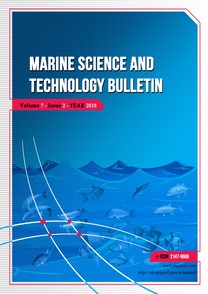An Empirical Study of R Applications for Data Analysis in Marine Geology
R programming, statistical analysis, Mariana Trench bathymetry,
___
- Butuzova, G. Y. (2003). Hydrothermal–Sedimentary Ore Formation in the World Ocean. Geos, Moscow, Russia. 136p.
- Dubinin, E. P. & Ushakov, S. A. (2001). Oceanic Rift Genesis. Geos, Moscow, Russia. 293p.
- Gardner, J. V., Armstrong, A. A., Calder, B. R. & Beaudoin, J. (2014). So, How Deep Is The Mariana Trench? Marine Geodesy, 37(1): 1–13.
- Garfunkel, Z., Anderson, C. A. & Schubert, G. (1986). Mantle Circulation and the Lateral Migration of Subducted Slabs. Journal of Geophysical Research, 91: 7205–7223.
- Gurevich, E. G. (1998). Metalliferous Sediments in the World Ocean. Nauchnyy Mir, Moscow, Russia. 340p.
- Horleston, A. C. & Helffrich, G. R. (2012). Constraining Sediment Subduction: A Converted Phase Study of the Aleutians and Marianas. Earth and Planetary Science Letters, 359–360: 141–151.
- Husson, L. (2012). Trench Migration and Upper Plate Strain over a Convecting Mantle. Physics of the Earth and Planetary Interiors, 212–213: 32–43.
- Ishibashi, J., Tsunogai, U., Toki, T., Ebina, N., Gamo, T., Sano, Y., Masuda, H. & Chiba, H. (2015). Chemical Composition of Hydrothermal Fluids in the Central and Southern Mariana Trough Backarc Basin. Deep–Sea Research Part II: Topical Studies in Oceanography, 121: 126–136.
- Lin, J. W. B. (2008). Qtcm 0.1.2: A Python Implementation of the Neelin–Zeng Quasi–Equilibrium Tropical Circulation Model. Geoscientific Model Development, 1: 315–344.
- Marta–Almeida, M., Ruiz–Villarreal, M., Otero, P., Cobas, P., Peliz, A., Nolasco, R., Cirano, M. & Pereira, J. (2011). OOF3: A Python Engine for Automating Regional and Coastal Ocean Forecasts. Environmental Modelling & Software, 26: 680–682.
- Oliphant, T. E. (2007). Python for Scientific Computing. Computing in Science & Engineering, 9: 10–20.
- R Core Team (2018). R: A Language and Environment for Statistical Computing. R Foundation for Statistical Computing, Vienna. https://www.R–project.org
- Roberts, J. J., Best, B. D., Dunn, D. C., Treml, E. A. & Halpin, P. N. (2010). Marine Geo–Spatial Ecology Tools: An Integrated Framework for Ecological Geoprocessing with ArcGIS, Python, R, MATLAB, and C++. Environmental Modelling & Software, 25: 1197–1207.
- Uyeda, S. & Kanamori, H. (1979). Back–Arc Opening and the Mode of Subduction. Journal of Geophysical Research, 84: 2017–2037.
- Warner, J. C., Perlin, N. & Skyllingstad, E. D. (2008). Using the Model Coupling Toolkit to Couple Earth System Models. Environmental Modelling & Software, 23: 1240–1249.
- ISSN: 2147-9666
- Yayın Aralığı: 4
- Başlangıç: 2012
- Yayıncı: Adem Yavuz SÖNMEZ
Deniz AYAS, Elif ELİUZ, Ferit PERİ, Mısra BAKAN
The Reflection of Ship Demolition Prices to Construction Costs in Turkey
An empirical study of R applications for data analysis in marine geology
Deniz AYAS, Nuray ÇİFTÇİ, Mustafa DOĞANGÜN, Mısra BAKAN
Determination of Usage Potential of Some Mediterranean Rays in Fish Oil Production
Mısra Bakan, Elif Ayşe Erdoğan Eliuz, Deniz Ayas, Ferit Peri
Mısra Bakan, Deniz Ayas, Nuray ÇİFTÇİ, Mustafa Doğangün
Identification of Mislabelling in Frozen Fish Fillets Based on DNA Barcoding Analysis
